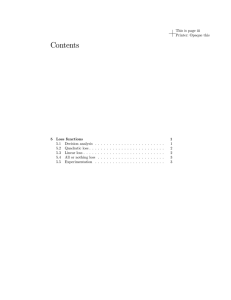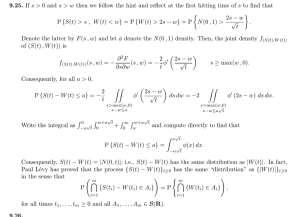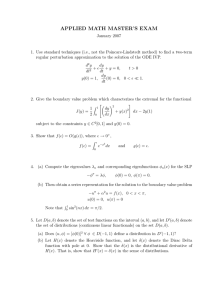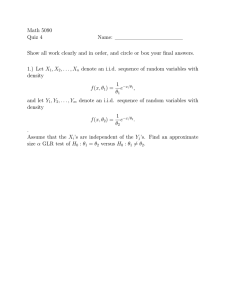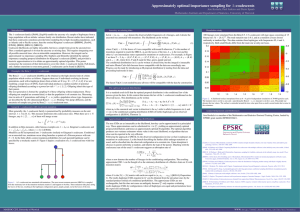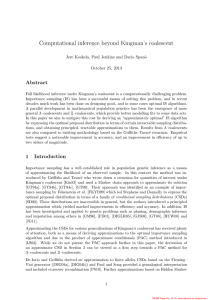M A S O D
advertisement
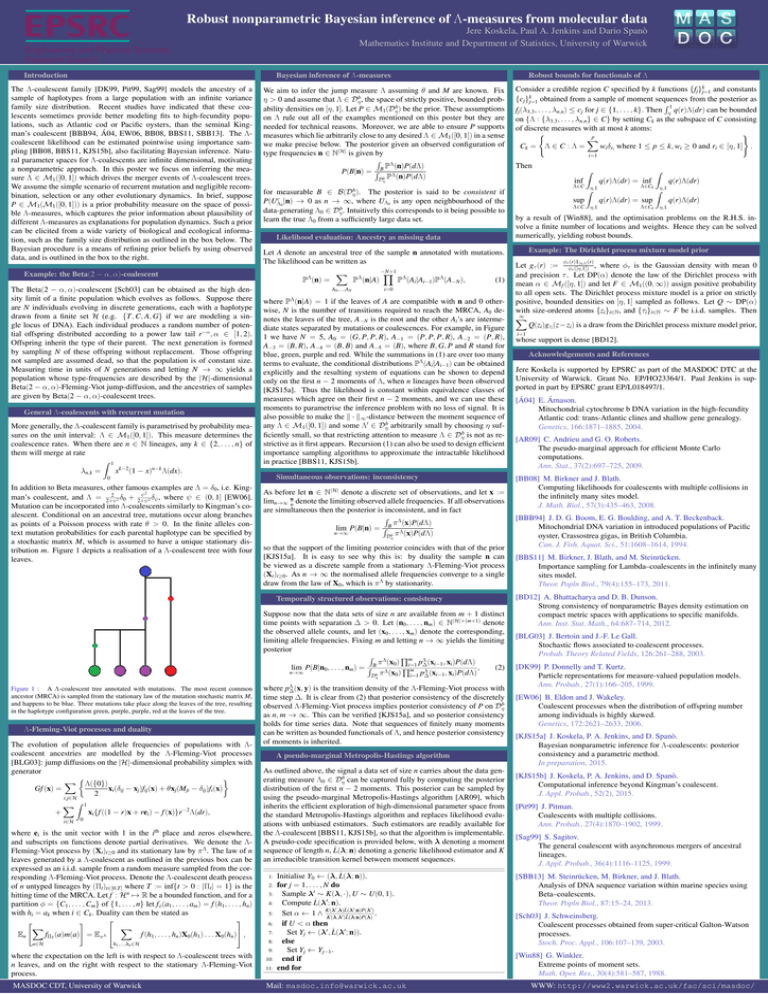
M A S
D O C
Robust nonparametric Bayesian inference of Λ-measures from molecular data
Jere Koskela, Paul A. Jenkins and Dario Spanò
Mathematics Institute and Department of Statistics, University of Warwick
Bayesian inference of Λ-measures
Introduction
The Λ-coalescent family [DK99, Pit99, Sag99] models the ancestry of a
sample of haplotypes from a large population with an infinite variance
family size distribution. Recent studies have indicated that these coalescents sometimes provide better modeling fits to high-fecundity populations, such as Atlantic cod or Pacific oysters, than the seminal Kingman’s coalescent [BBB94, Á04, EW06, BB08, BBS11, SBB13]. The Λcoalescent likelihood can be estimated pointwise using importance sampling [BB08, BBS11, KJS15b], also facilitating Bayesian inference. Natural parameter spaces for Λ-coalescents are infinite dimensional, motivating
a nonparametric approach. In this poster we focus on inferring the measure Λ ∈ M1([0, 1]) which drives the merger events of Λ-coalescent trees.
We assume the simple scenario of recurrent mutation and negligible recombination, selection or any other evolutionary dynamics. In brief, suppose
P ∈ M1(M1([0, 1])) is a prior probability measure on the space of possible Λ-measures, which captures the prior information about plausibility of
different Λ-measures as explanations for population dynamics. Such a prior
can be elicited from a wide variety of biological and ecological information, such as the family size distribution as outlined in the box below. The
Bayesian procedure is a means of refining prior beliefs by using observed
data, and is outlined in the box to the right.
We aim to infer the jump measure Λ assuming θ and M are known. Fix
η > 0 and assume that Λ ∈ Dηb, the space of strictly positive, bounded probability densities on [η, 1]. Let P ∈ M1(Dηb) be the prior. These assumptions
on Λ rule out all of the examples mentioned on this poster but they are
needed for technical reasons. Moreover, we are able to ensure P supports
measures which lie arbitrarily close to any desired Λ ∈ M1([0, 1]) in a sense
we make precise below. The posterior given an observed configuration of
type frequencies n ∈ N|H| is given by
R Λ
P (n)P(dΛ)
P(B|n) = R B Λ
Db P (n)P(dΛ)
General Λ-coalescents with recurrent mutation
More generally, the Λ-coalescent family is parametrised by probability measures on the unit interval: Λ ∈ M1([0, 1]). This measure determines the
coalescence rates. When there are n ∈ N lineages, any k ∈ {2, . . . , n} of
them will merge at rate
Z 1
λn,k =
xk−2(1 − x)n−k Λ(dx).
for measurable B ∈ B(Dηb). The posterior is said to be consistent if
P(UΛc 0 |n) → 0 as n → ∞, where UΛ0 is any open neighbourhood of the
data-generating Λ0 ∈ Dηb. Intuitively this corresponds to it being possible to
learn the true Λ0 from a sufficiently large data set.
Likelihood evaluation: Ancestry as missing data
Let A denote an ancestral tree of the sample n annotated with mutations.
The likelihood can be written as
PΛ(n) =
X
PΛ(n|A)
A0 ,...,AN
−N+1
Y
PΛ(Ai|Ai−1)PΛ(A−N ),
(1)
i=0
where PΛ(n|A) = 1 if the leaves of A are compatible with n and 0 otherwise, N is the number of transitions required to reach the MRCA, A0 denotes the leaves of the tree, A−N is the root and the other Ai’s are intermediate states separated by mutations or coalescences. For example, in Figure
1 we have N = 5, A0 = (G, P, P, R), A−1 = (P, P, P, R), A−2 = (P, R),
A−3 = (B, R), A−4 = (B, B) and A−5 = (B), where B, G, P and R stand for
blue, green, purple and red. While the summations in (1) are over too many
terms to evaluate, the conditional distributions PΛ(Ai|Ai−1) can be obtained
explicitly and the resulting system of equations can be shown to depend
only on the first n − 2 moments of Λ, when n lineages have been observed
[KJS15a]. Thus the likelihood is constant within equivalence classes of
measures which agree on their first n − 2 moments, and we can use these
moments to parametrise the inference problem with no loss of signal. It is
also possible to make the k · k∞-distance between the moment sequence of
any Λ ∈ M1([0, 1]) and some Λ0 ∈ Dηb arbitrarily small by choosing η sufficiently small, so that restricting attention to measure Λ ∈ Dηb is not as restrictive as it first appears. Recursion (1) can also be used to design efficient
importance sampling algorithms to approximate the intractable likelihood
in practice [BBS11, KJS15b].
Simultaneous observations: inconsistency
0
In addition to Beta measures, other famous examples are Λ = δ0, i.e. Kingψ2
2
man’s coalescent, and Λ = 2+ψ
2 δ0 + 2+ψ 2 δψ , where ψ ∈ (0, 1] [EW06].
Mutation can be incorporated into Λ-coalescents similarly to Kingman’s coalescent. Conditional on an ancestral tree, mutations occur along branches
as points of a Poisson process with rate θ > 0. In the finite alleles context mutation probabilities for each parental haplotype can be specified by
a stochastic matrix M, which is assumed to have a unique stationary distribution m. Figure 1 depicts a realisation of a Λ-coalescent tree with four
leaves.
As before let n ∈ N|H| denote a discrete set of observations, and let x :=
limn→∞ nn denote the limiting observed allele frequencies. If all observations
are simultaneous then the posterior is inconsistent, and in fact
R Λ
π (x)P(dΛ)
lim P(B|n) = R B Λ
n→∞
Db π (x)P(dΛ)
η
so that the support of the limiting posterior coincides with that of the prior
[KJS15a]. It is easy to see why this is: by duality the sample n can
be viewed as a discrete sample from a stationary Λ-Fleming-Viot process
(Xt )t≥0. As n → ∞ the normalised allele frequencies converge to a single
draw from the law of X0, which is π Λ by stationarity.
Temporally structured observations: consistency
Suppose now that the data sets of size n are available from m + 1 distinct
time points with separation ∆ > 0. Let (n0, . . . , nm) ∈ N|H|×(m+1) denote
the observed allele counts, and let (x0, . . . , xm) denote the corresponding,
limiting allele frequencies. Fixing m and letting n → ∞ yields the limiting
posterior
R Λ
Qm Λ
π
(x
)
p∆(xi−1, xi)P(dΛ)
0
Qi=1
lim P(B|n0, . . . , nm) = R B Λ
,
(2)
m
Λ
n→∞
i=1 p∆ (xi−1 , xi )P(dΛ)
Db π (x0 )
η
Figure 1 : A Λ-coalescent tree annotated with mutations. The most recent common
ancestor (MRCA) is sampled from the stationary law of the mutation stochastic matrix M,
and happens to be blue. Three mutations take place along the leaves of the tree, resulting
in the haplotype configuration green, purple, purple, red at the leaves of the tree.
Λ-Fleming-Viot processes and duality
The evolution of population allele frequencies of populations with Λcoalescent ancestries are modelled by the Λ-Fleming-Viot processes
[BLG03]: jump diffusions on the |H|-dimensional probability simplex with
generator
X Λ({0})
Gf (x) =
xi(δij − xj)fij(x) + θxj(Mji − δij)fi(x)
2
i,j∈H
XZ 1
+
xi{f ((1 − r)x + rei) − f (x)}r−2Λ(dr),
i∈H
0
where ei is the unit vector with 1 in the ith place and zeros elsewhere,
and subscripts on functions denote partial derivatives. We denote the ΛFleming-Viot process by (Xt )t≥0 and its stationary law by π Λ. The law of n
leaves generated by a Λ-coalescent as outlined in the previous box can be
expressed as an i.i.d. sample from a random measure sampled from the corresponding Λ-Fleming-Viot process. Denote the Λ-coalescent death process
of n untyped lineages by (Πt )t∈[0,T] where T := inf{t > 0 : |Πt | = 1} is the
hitting time of the MRCA. Let f : Hn 7→ R be a bounded function, and for a
partition φ = {C1, . . . , Cm} of {1, . . . , n} let fφ(a1, . . . , am) = f (h1, . . . , hn)
with hi = ak when i ∈ Ck . Duality can then be stated as
"
#
X
X
En
fΠT (a)m(a) = EπΛ
f (h1, . . . , hn)X0(h1) . . . X0(hn) ,
a∈H
h1 ,...,hn ∈H
where the expectation on the left is with respect to Λ-coalescent trees with
n leaves, and on the right with respect to the stationary Λ-Fleming-Viot
process.
MASDOC CDT, University of Warwick
Consider a credible region C specified by k functions {fj}kj=1 and constants
{cj}kj=1 obtained from a sample of moment sequences from the posterior as
R1
fj(λ3,3, . . . , λn,n) ≤ cj for j ∈ {1, . . . , k}. Then η q(r)Λ(dr) can be bounded
on {Λ : {λ3,3, . . . , λn,n} ∈ C} by setting Ck as the subspace of C consisting
of discrete measures with at most k atoms:
(
)
p
X
Ck = Λ ∈ C : Λ =
wiδri where 1 ≤ p ≤ k, wi ≥ 0 and ri ∈ [η, 1] .
i=1
Then
where pΛ∆(x, y) is the transition density of the Λ-Fleming-Viot process with
time step ∆. It is clear from (2) that posterior consistency of the discretely
observed Λ-Fleming-Viot process implies posterior consistency of P on Dηb
as n, m → ∞. This can be verified [KJS15a], and so posterior consistency
holds for time series data. Note that sequences of finitely many moments
can be written as bounded functionals of Λ, and hence posterior consistency
of moments is inherited.
A pseudo-marginal Metropolis-Hastings algorithm
As outlined above, the signal a data set of size n carries about the data generating measure Λ0 ∈ Dηb can be captured fully by computing the posterior
distribution of the first n − 2 moments. This posterior can be sampled by
using the pseudo-marginal Metropolis-Hastings algorithm [AR09], which
inherits the efficient exploration of high-dimensional parameter space from
the standard Metropolis-Hastings algorithm and replaces likelihood evaluations with unbiased estimators. Such estimators are readily available for
the Λ-coalescent [BBS11, KJS15b], so that the algorithm is implementable.
A pseudo-code specification is provided below, with λ denoting a moment
sequence of length n, L̂(λ; n) denoting a generic likelihood estimator and K
an irreducible transition kernel between moment sequences.
1:
2:
3:
4:
5:
6:
7:
8:
9:
10:
11:
Initialise Y0 ← (λ, L̂(λ; n)).
for j = 1, . . . , N do
Sample λ0 ∼ K(λ, ·), U ∼ U(0, 1).
Compute L̂(λ0; n).
K(λ0 ,λ)L̂(λ0 ;n)P(λ0 )
Set α ← 1 ∧ K(λ,λ0)L̂(λ;n)P(λ) .
if U < α then
Set Yj ← (λ0, L̂(λ0; n)).
else
Set Yj ← Yj−1.
end if
end for
Mail: masdoc.info@warwick.ac.uk
Z
Z
q(r)Λ(dr) = inf
inf
η
Example: the Beta(2 − α, α)-coalescent
The Beta(2 − α, α)-coalescent [Sch03] can be obtained as the high density limit of a finite population which evolves as follows. Suppose there
are N individuals evolving in discrete generations, each with a haplotype
drawn from a finite set H (e.g. {T, C, A, G} if we are modeling a single locus of DNA). Each individual produces a random number of potential offspring distributed according to a power law tail r−α , α ∈ [1, 2).
Offspring inherit the type of their parent. The next generation is formed
by sampling N of these offspring without replacement. Those offspring
not sampled are assumed dead, so that the population is of constant size.
Measuring time in units of N generations and letting N → ∞ yields a
population whose type-frequencies are described by the |H|-dimensional
Beta(2 − α, α)-Fleming-Viot jump-diffusion, and the ancestries of samples
are given by Beta(2 − α, α)-coalescent trees.
Robust bounds for functionals of Λ
Λ∈C
Λ∈Ck
Zη,1
sup
q(r)Λ(dr) = sup
Λ∈C
Λ∈Ck
η,1
q(r)Λ(dr)
Zη,1
q(r)Λ(dr)
η,1
by a result of [Win88], and the optimisation problems on the R.H.S. involve a finite number of locations and weights. Hence they can be solved
numerically, yielding robust bounds.
Example: The Dirichlet process mixture model prior
φ (r)1
(r)
[η,1]
Let gτ (r) := τφτ ([η,1])
, where φτ is the Gaussian density with mean 0
and precision τ . Let DP(α) denote the law of the Dirichlet process with
mean α ∈ Mf ([η, 1]) and let F ∈ M1((0, ∞)) assign positive probability
to all open sets. The Dirichlet process mixture model is a prior on strictly
positive, bounded densities on [η, 1] sampled as follows. Let Q ∼ DP(α)
with size-ordered atoms {zi}i∈N, and {τi}i∈N ∼ F be i.i.d. samples. Then
∞
X
Q(zi)gτi (z−zi) is a draw from the Dirichlet process mixture model prior,
i=1
whose support is dense [BD12].
Acknowledgements and References
Jere Koskela is supported by EPSRC as part of the MASDOC DTC at the
University of Warwick. Grant No. EP/HO23364/1. Paul Jenkins is supported in part by EPSRC grant EP/L018497/1.
[Á04] E. Árnason.
Mitochondrial cytochrome b DNA variation in the high-fecundity
Atlantic cod: trans-Atlantic clines and shallow gene genealogy.
Genetics, 166:1871–1885, 2004.
[AR09] C. Andrieu and G. O. Roberts.
The pseudo-marginal approach for efficient Monte Carlo
computations.
Ann. Stat., 37(2):697–725, 2009.
[BB08] M. Birkner and J. Blath.
Computing likelihoods for coalescents with multiple collisions in
the infinitely many sites model.
J. Math. Biol., 57(3):435–463, 2008.
[BBB94] J. D. G. Boom, E. G. Boulding, and A. T. Beckenback.
Mitochondrial DNA variation in introduced populations of Pacific
oyster, Crassostrea gigas, in British Columbia.
Can. J. Fish. Aquat. Sci., 51:1608–1614, 1994.
[BBS11] M. Birkner, J. Blath, and M. Steinrücken.
Importance sampling for Lambda–coalescents in the infinitely many
sites model.
Theor. Popln Biol., 79(4):155–173, 2011.
[BD12] A. Bhattacharya and D. B. Dunson.
Strong consistency of nonparametric Bayes density estimation on
compact metric spaces with applications to specific manifolds.
Ann. Inst. Stat. Math., 64:687–714, 2012.
[BLG03] J. Bertoin and J.-F. Le Gall.
Stochastic flows associated to coalescent processes.
Probab. Theory Related Fields, 126:261–288, 2003.
[DK99] P. Donnelly and T. Kurtz.
Particle representations for measure-valued population models.
Ann. Probab., 27(1):166–205, 1999.
[EW06] B. Eldon and J. Wakeley.
Coalescent processes when the distribution of offspring number
among individuals is highly skewed.
Genetics, 172:2621–2633, 2006.
[KJS15a] J. Koskela, P. A. Jenkins, and D. Spanò.
Bayesian nonparametric inference for Λ-coalescents: posterior
consistency and a parametric method.
In preparation, 2015.
[KJS15b] J. Koskela, P. A. Jenkins, and D. Spanò.
Computational inference beyond Kingman’s coalescent.
J. Appl. Probab., 52(2), 2015.
[Pit99] J. Pitman.
Coalescents with multiple collisions.
Ann. Probab., 27(4):1870–1902, 1999.
[Sag99] S. Sagitov.
The general coalescent with asynchronous mergers of ancestral
lineages.
J. Appl. Probab., 36(4):1116–1125, 1999.
[SBB13] M. Steinrücken, M. Birkner, and J. Blath.
Analysis of DNA sequence variation within marine species using
Beta–coalescents.
Theor. Popln Biol., 87:15–24, 2013.
[Sch03] J. Schweinsberg.
Coalescent processes obtained from super-critical Galton-Watson
processes.
Stoch. Proc. Appl., 106:107–139, 2003.
[Win88] G. Winkler.
Extreme points of moment sets.
Math. Oper. Res., 30(4):581–587, 1988.
WWW: http://www2.warwick.ac.uk/fac/sci/masdoc/


